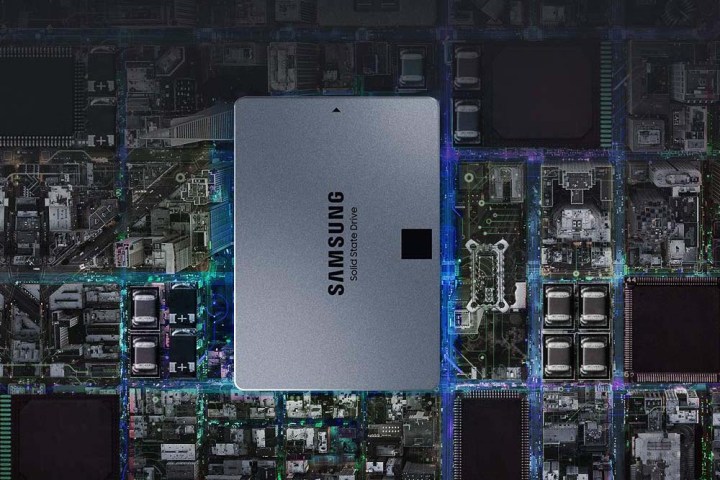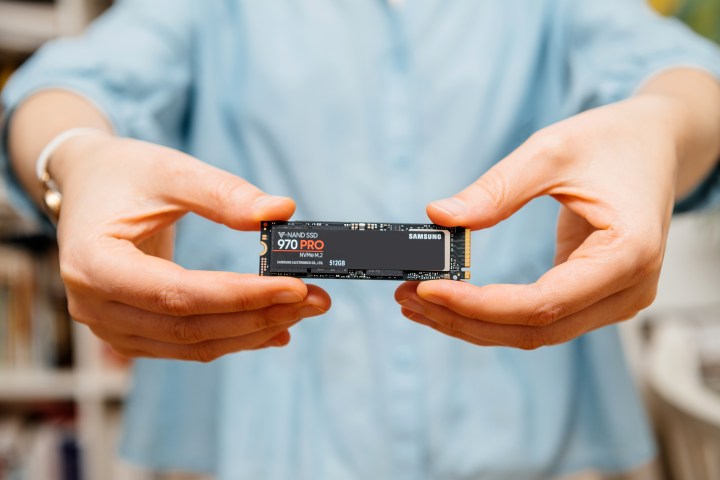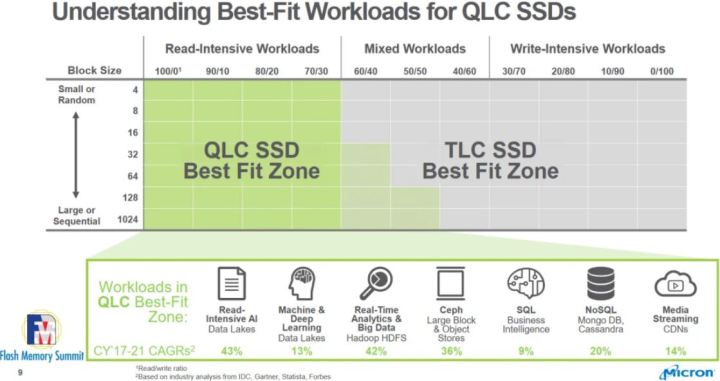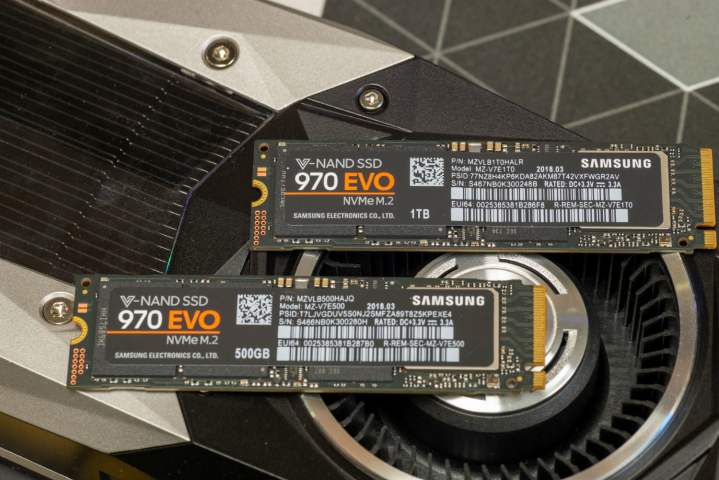Samsung makes some of the best SSDs (solid-state drives) on the market, so if you’re looking to speed up your storage, it makes perfect sense to check out this brand. However, it can be hard to tell which Samsung SSD to pick, simply because Samsung’s naming convention doesn’t give anything away.
Many of us are left wondering: What’s the difference between the different SSD lines? Which model wins in a battle of Samsung QVO versus Samsung EVO? The drives vary in a few ways, from pricing to performance and longevity. In this guide, we’ll delve deeper into the differences between the Samsung QVO and Samsung EVO SSDs.

It all comes down to flash memory type
For a long time, Samsung offered two types of SSDs — the Samsung Pro and the Samsung EVO. In 2020, the company also launched its third line of SSDs, dubbed the Samsung QVO. While all three are available to consumer-level PC builders, the Pro SSDs are the most expensive, while the other two types are more affordable.
The main difference between these three brands stems from the type of flash memory they use. SSDs use non-volatile flash memory, which is a type of memory that can store data for long periods of time and doesn’t require constant power. All three Samsung SSD lines use NAND (which stands for “Not And” and is an electronic logic gate) flash memory to persistently store data, but the exact technology varies between all three.
NAND flash memory typically comes in the following types:
- Single-level cell (SLC) NAND is typically the most expensive of all, but it tends to have a high endurance. It stores 1 bit of data per memory cell.
- Multi-level cell (MLC) NAND is often less expensive than SLC while still offering great longevity. It can hold 2 bits of data per memory cell.
- Triple-level cell (TLC) NAND offers a higher storage density than the previous two, but it also tends to have worse performance and longevity. It holds 3 bits of data per cell.
- Quad-level cell (QLC) NAND is perhaps the cheapest of all four types. Unsurprisingly, it also offers the shortest lifespan of the four. Following the trend, QLC NAND stores 4 bits of data per cell.
- 3D NAND refers to stacking multiple NAND chips within a single SSD. It offers much higher storage density, but it’s not practical in consumer builds due to higher costs and power requirements.
Samsung QVO vs EVO — the differences explained
Knowing that QVO, EVO, and Pro all use different NAND technologies, we can examine how this affects their performance. As you can tell from our quick explanation above, the difference in NAND flash memory means that we can expect different things from each drive.
Samsung EVO SSDs use TLC NAND (3 bits per cell) while the new QVO line uses QLC (4 bits per cell). For reference, Samsung Pro SSDs are made with MLC NAND (2 bits per cell), but below, we will focus on the differences between EVO and QVO.

Price
The Pro SSDs remain the most expensive that Samsung has on offer. In comparison, both the EVO and the QVO are more reasonably priced. Of the three of them, the new QVO drives are by far the cheapest.
The Samsung 870 EVO is an excellent drive and is usually priced betweeen $120 and $170 on Amazon for 1TB of storage. The cheaper equivalent of that drive, the Samsung 870 QVO, usually comes with a price tag of around $100 to $130.
Although prices may vary between models and, of course, storage capacities, QVO drives are generally much cheaper than EVO. With that said, the lower price comes at a performance cost.
Storage size
While EVO drives are more expensive than QVO, it’s the new QVO line of SSDs that wins in terms of storage capacity. While different models offer different capacities, comparing two similar products from each line (870 EVO and 870 QVO) gives us an accurate idea of what we can expect in terms of storage space.
The Samsung 870 EVO comes with either 250GB, 500GB, 1TB, 2TB, or 4TB of storage at most. The newer 870 QVO has a larger capacity right out of the gate, with the smallest drive offering 1TB, followed by 2TB, 4TB, and lastly, a whopping 8TB. This makes it one of the largest consumer-level SSDs available on the market.
Realistically, most of us will not need 8TB of SSD storage. Such a massive SSD is also expensive, with Amazon prices hovering around the $850 mark (although you may snag it for as little as $710 on a discount). However, if we’re looking at the possibilities alone, QVO drives offer higher capacities.
Longevity
The lifespan of an SSD is measured in terabytes written (TBW), which tells you how many terabytes of data you can write to the SSD before it reaches the end of its lifespan and eventually breaks down.
You probably guessed by now that QVO drives generally offer a shorter lifespan than their EVO counterparts. Looking at Samsung’s product pages gives us an idea of how much we can expect from each drive. We will only compare the SSD sizes that both models can offer, ignoring the smallest EVOs and the largest QVO.
Once again, let’s compare the Samsung 870 EVO and the Samsung 870 QVO:
- 1TB disk size: 600 TBW for the EVO, 360 TBW for the QVO
- 2TB disk size: 1,200 TBW for the EVO, 720 TBW for the QVO
- 4TB disk size: 2,400 TBW for the EVO, 1,440 TBW for the QVO
While the above differences in TBW are huge, they may not mean all that much for regular users. It’s worth noting that the exact numbers vary from drive to drive, and just because an SSD is given a warrantied TBW of 1,440 doesn’t necessarily mean it won’t break down well before reaching that threshold. All it means is that it’s still under warranty and may be replaced by the manufacturer. Similarly, some SSDs continue functioning well beyond their expected lifespan.
With all that said, as a general rule of thumb, you can expect the Samsung EVO to last longer than the Samsung QVO, but don’t forget the disclaimer above: A lot of it comes down to circumstance.

Performance
Read and write speeds are very important for SSD users. After all, you’re investing in a more expensive drive in order to see a huge improvement from your standard hard drive (HDD.) However, performance is yet another factor where EVO and QVO tend to differ.
As Samsung QVO uses QLC NAND, it’s the slowest of all flash memory types. On paper, this may not mean much. According to Samsung, both the 870 EVO and the 870 QVO offer 520MBps write speeds and 550MBps read speeds. However, this is with the use of Samsung’s Intelligent TurboWrite technology.
TurboWrite accelerates write speeds, temporarily boosting the speed at which the SSD can move data, almost simulating the speeds of technically better NAND types. However, there is a maximum data capacity that Intelligent TurboWrite can function for. After around 42GB to 72GB of transferred data, the speed goes down to what can typically be expected of that particular technology.
As a result, while the QVO will keep up with the EVO during Intelligent TurboWrite, it will fall behind in terms of speed once that’s used up because TLC memory is typically significantly faster than QLC memory.
Usage
Taking all the above factors into consideration might make you think that the Samsung EVO wins in each and every way, and while this is true, it’s not quite as simple as that.
As you can tell by the different capacities offered by these SSDs, it’s likely that Samsung intended for them to be used for different purposes. Samsung QVO drives are bigger, but due to their slower speeds, they’re better used for storage than for the purpose of tasks that require constant read and write actions.

Many users may decide to buy a smaller TLC SSD for their operating system and some of their most-used programs and then go with a cheaper QLC drive for storing files and software that doesn’t need to load quite as quickly. In general, as shown on the above graph from Micron, the Samsung QVO line will excel at read-intensive workloads but will lag behind when it comes to write-intensive tasks.
Samsung QVO vs Samsung EVO — which one is better?
While enthusiasts tend to search for the best processors and the greatest graphics cards, SSDs are more often overlooked and bought on a basis of read/write speeds and capacity. However, as you can tell, there is more to it than meets the eye, and similarly-priced drives may sometimes perform differently.
On paper, it’s hard to deny that the Samsung EVO line of SSDs will perform better and may enjoy greater longevity than the Samsung QVO. On the other hand, many users won’t notice much of a difference in day-to-day tasks, and unless you’re in a big hurry, you likely won’t mind whether it takes you 30 seconds or 3 minutes to transfer a big file.
The biggest difference between the two drive brands comes down to their use cases. If you’re looking for an SSD to install your operating system on, you’re probably better off buying a smaller Samsung EVO, such as the 970 EVO that we were once very impressed by or the cheaper 860 EVO. However, if you just want bulk storage with faster speeds than typical HDDs, you’ll most likely be satisfied with a Samsung QVO.

Samsung QVO vs Samsung EVO FAQ
Which is better: 870 EVO or 870 QVO?
Judging strictly by performance and longevity, the Samsung 870 EVO SSD will be better than the 870 QVO. It’s typically faster without slowing down after a certain storage cap the way that QVO does, it should offer a longer lifespan, and it still comes with ample storage for those who want a larger drive.
Is Samsung QVO good enough?
Samsung QVO SSDs are some of the most budget-friendly and easily accessible drives on the market. While they are not quite as good as EVO, they still have much to offer and are by no means bad. The average user may not easily notice a difference between the three Samsung drive types (Pro, QVO, EVO).
Is EVO a TLC or MLC?
Samsung refers to the EVO SSDs as “3bit MLC.” However, that just indicates that it is indeed a triple-level cell (TLC) drive because MLC only refers to NAND flash memory types that store 2 bits of data per memory cell. In other words, the Samsung EVO SSD is a TLC.
Editors' Recommendations
- SATA vs. PCIe: the important difference you need to know
- Samsung Odyssey OLED 49 vs. Odyssey Neo G9 (2023)
- Samsung reaches new heights with this SSD, but it could go even higher
- The best NVMe SSD in 2022
- NVMe vs. SSD: What’s the difference?




